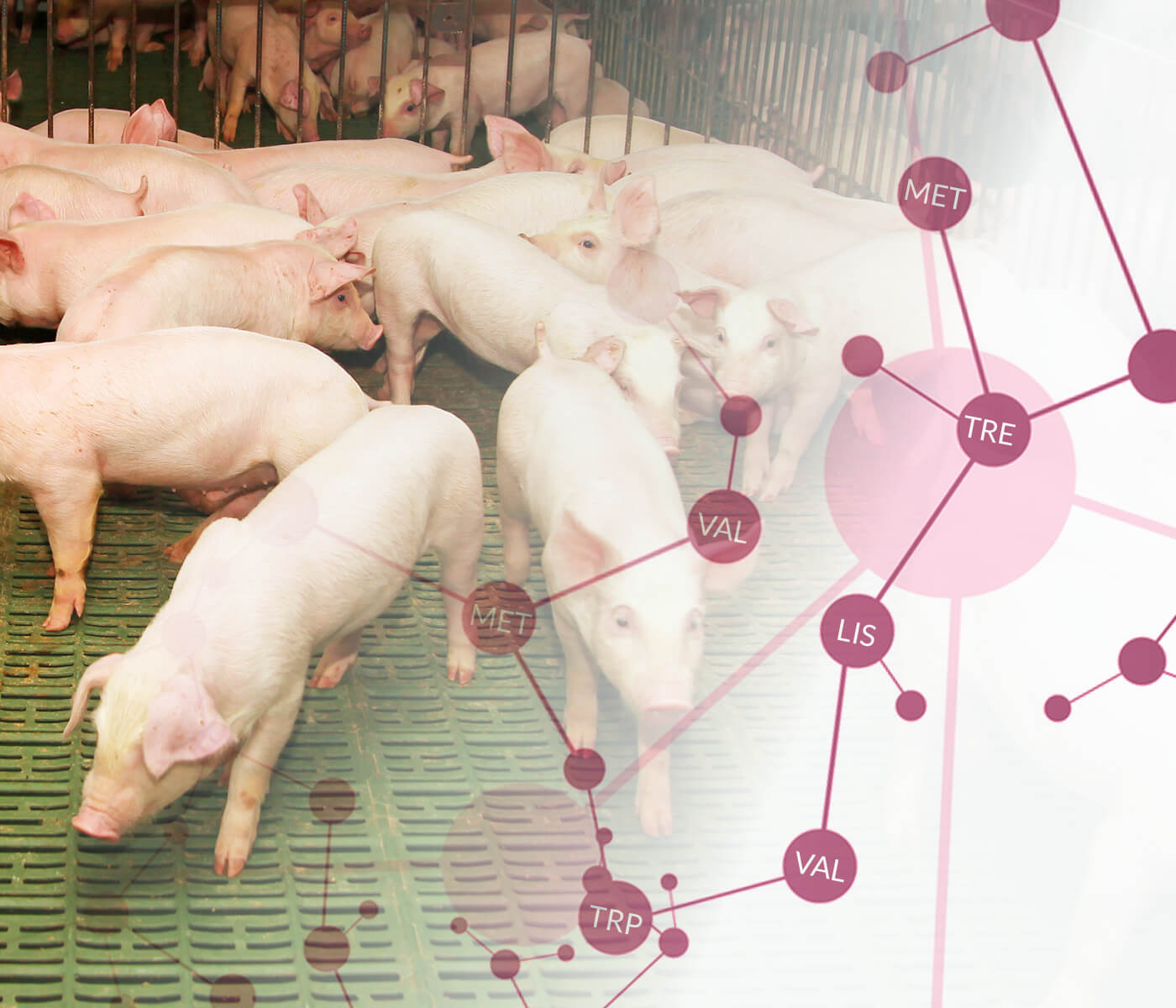Advancements, Implications, and Constraints of Low-Crude-Protein Diets in Swine Farming
| Introduction |
Feeding programs in pig production are usually divided into three phases: nursery, growth, and finishing (Rostagno et al., 2017). In each of these phases, it is essential to provide an adequate supply of dietary crude protein (CP) to meet the requirements for essential amino acids and nitrogen (N) for non-essential amino acid synthesis (van Milgen and Dourmad, 2015).
![]() Consequently, the emphasis has shifted towards supplying a comprehensive array of amino acids rather than solely focusing on CP, as this approach is more widely acknowledged (Millet et al., 2018).
Consequently, the emphasis has shifted towards supplying a comprehensive array of amino acids rather than solely focusing on CP, as this approach is more widely acknowledged (Millet et al., 2018).
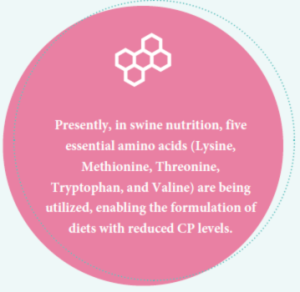
Moreover, the inclusion of the amino acid Isoleucine in diets depends on its economic value and the specific feeding program.
Experimental studies have shown that even lower levels of CP can be achieved by supplementing amino acids such as Histidine, Leucine, and Phenylalanine.
 Nonetheless, excessively low levels of crude protein can adversely impact swine performance due to the reduction of non-essential amino acids, intact protein, and essential bioactive compounds such as peptides and isoflavones in the diet.
Nonetheless, excessively low levels of crude protein can adversely impact swine performance due to the reduction of non-essential amino acids, intact protein, and essential bioactive compounds such as peptides and isoflavones in the diet.
Indeed, altering the CP level in the diet, even while keeping the ideal ratios of essential amino acids with Lys, has shown negative effects on swine performance.
 The objective of this review is to examine the advancements and consequences of low-crude-protein diets that are well-balanced for all essential amino acids and their influence on swine performance.
The objective of this review is to examine the advancements and consequences of low-crude-protein diets that are well-balanced for all essential amino acids and their influence on swine performance.
Benefits and Limitations of Low-Crude-Protein Diets
From a performance standpoint:
![]() The economic efficiency of low-Crude-Protein diets can vary depending on ingredient prices and how the animals respond to the diet.
The economic efficiency of low-Crude-Protein diets can vary depending on ingredient prices and how the animals respond to the diet.
![]() Low-crude-protein diets have well-established environmental benefits due to reduced nitrogen excretion.
Low-crude-protein diets have well-established environmental benefits due to reduced nitrogen excretion.
![]() Balanced low-crude-protein diets supplemented with essential amino acids have been employed to enhance intestinal health in swine.
Balanced low-crude-protein diets supplemented with essential amino acids have been employed to enhance intestinal health in swine.
![]() Through the reduction of soybean meal content, low-crude-protein diets exhibit decreased levels of indigestible carbohydrates (stachyose and raffinose) and antigenic proteins (glycinin and β-conglycinin), which are known as antinutritional factors.
Through the reduction of soybean meal content, low-crude-protein diets exhibit decreased levels of indigestible carbohydrates (stachyose and raffinose) and antigenic proteins (glycinin and β-conglycinin), which are known as antinutritional factors.
![]() Additionally, low-crude-protein diets may have the potential to reduce the proliferation of pathogenic bacteria and toxins in the gastrointestinal tract, including ammonia and polyamines.
Additionally, low-crude-protein diets may have the potential to reduce the proliferation of pathogenic bacteria and toxins in the gastrointestinal tract, including ammonia and polyamines.
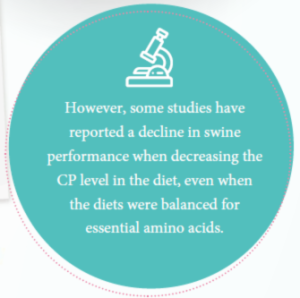
While research has focused on ensuring sufficient provision of essential amino acids, the literature provides explanations for the detrimental effects on swine performance when low-crude-protein diets are employed.
 The synthesis of non-essential amino acids from essential ones may pose a limiting factor in swine performance when utilizing low-crude-protein diets (Peng et al., 2016).
The synthesis of non-essential amino acids from essential ones may pose a limiting factor in swine performance when utilizing low-crude-protein diets (Peng et al., 2016).
Pigs fed low-crude-protein diets have exhibited decreased blood levels of non-essential amino acids, especially Arg, Gln, Glu, and Pro (Zhang et al., 2013).
![]() As a result, certain non-essential amino acids may become functionally essential and, thus, deficient in low-Crude-Protein diets.
As a result, certain non-essential amino acids may become functionally essential and, thus, deficient in low-Crude-Protein diets.
![]() Under such circumstances, supplementing these non-essential amino acids may be essential to maintain swine health and growth.
Under such circumstances, supplementing these non-essential amino acids may be essential to maintain swine health and growth.
| Meta analysis |
Due to discrepancies in the literature and the practical implications for swine formulation strategies, a meta-analysis was conducted to determine the minimum CP level that would not compromise swine growth performance.
Additionally, the supplementation of industrial amino acids allows for the reduction of protein sources like soybean meal, which contains biologically active compounds such as isoflavones, saponins, and bioactive peptides that are essential for maintaining performance (Rochell et al., 2015).
![]() Furthermore, bioactive peptides have been suggested to possess antimicrobial, antioxidant, and immunomodulatory activities (Hou et al., 2017).
Furthermore, bioactive peptides have been suggested to possess antimicrobial, antioxidant, and immunomodulatory activities (Hou et al., 2017).
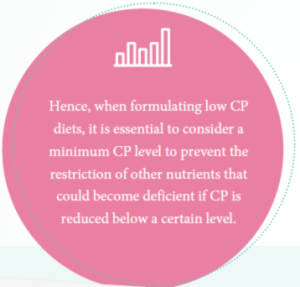
 A database was compiled from 46 publications, comprising a total of 60 experiments. The primary criteria used to select articles were as follows:
A database was compiled from 46 publications, comprising a total of 60 experiments. The primary criteria used to select articles were as follows:
- Assessment of various levels of crude protein.
- Comparable standardized ileal digestible lysine (SID Lys) and metabolizable energy (ME) between control and low-crude-protein treatments.
- Ensuring all essential amino acids in the diet met or surpassed the ideal ratio with Lys (NRC, 2012).
- Clearly documented performance outcomes.
The meta-analysis study utilized the NLIMIXED procedure of SAS (SAS, Inc., Cary, NC, USA) and employed a nonlinear statistical model.
Nursery Phase
According to NRC (2012) and Brazilian Tables (Rostagno et al., 2017), a corn and soybean meal-based diet for 7 kg body weight pigs typically contains approximately 20.5% CP.
 According to the current meta-analysis, the estimated breakpoint for CP was 18.4%, below which average daily gain (ADG) would be reduced. Taking into account feed efficiency, the estimated level was 18.3% CP.
According to the current meta-analysis, the estimated breakpoint for CP was 18.4%, below which average daily gain (ADG) would be reduced. Taking into account feed efficiency, the estimated level was 18.3% CP.
The suggested minimum CP level for nursery pig diets is lower than the levels recommended by NRC (2012) and Brazilian Tables (Rostagno et al., 2017), suggesting that CP levels lower than those provided in the Tables can be used for diet formulation in this phase.
 Moreover, the study also estimated the highest levels of industrial lysine that could be supplemented without compromising ADG and feed efficiency, which were 0.42% and 0.43% L-lysine, respectively.
Moreover, the study also estimated the highest levels of industrial lysine that could be supplemented without compromising ADG and feed efficiency, which were 0.42% and 0.43% L-lysine, respectively.
![]() This is equivalent to 0.54% L-lysine HCl (78.8% purity) or 0.71% L-lysine sulfate (60.0% purity).
This is equivalent to 0.54% L-lysine HCl (78.8% purity) or 0.71% L-lysine sulfate (60.0% purity).
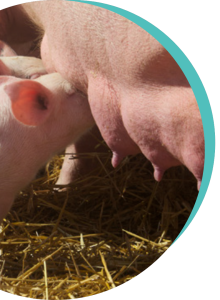 The utilization of the SID Lys:CP ratio can serve as a reliable indicator of the degree of CP reduction (Millet et al., 2018; Liu et al., 2019).
The utilization of the SID Lys:CP ratio can serve as a reliable indicator of the degree of CP reduction (Millet et al., 2018; Liu et al., 2019).
By considering the SID Lys:CP ratio, it was determined that 6.6% is the upper threshold beyond which both average daily gain (ADG) and feed efficiency would be compromised.
Growth phase
In contrast to the nursery phase, diets in the growth phase are formulated with a lower crude protein level.
According to the statistical model used in the current meta-analysis:
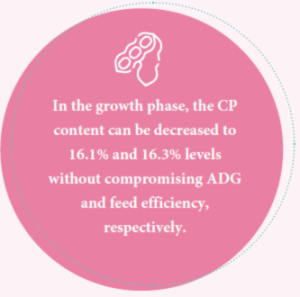
For a similar phase, NRC (2012) and Brazilian Tables (Rostagno et al., 2017) suggest 15.7% and 18.9% CP, respectively. The result found in the present study falls within these CP ranges.
![]() In the growth phase, determining a breakpoint for L-lysine supplementation or the SID Lys:CP ratio in performance was not possible. Nonetheless, the average maximum level of L-lysine supplementation in this phase was 0.42, equivalent to 0.53% L-lysine HCl or 0.70% L-lysine sulfate supplementation.
In the growth phase, determining a breakpoint for L-lysine supplementation or the SID Lys:CP ratio in performance was not possible. Nonetheless, the average maximum level of L-lysine supplementation in this phase was 0.42, equivalent to 0.53% L-lysine HCl or 0.70% L-lysine sulfate supplementation.
Finishing phase
Protein is an expensive nutrient, and due to the increased feed intake in the finishing phase, nutrient utilization efficiency directly impacts production system costs.
As per the Tables (NRC, 2012; Rostagno et al., 2017), a diet for the initial finishing phase (70 to 100 kg) can be formulated with around 12.3% CP, whereas a diet for the second finishing phase (100 kg to slaughter) with approximately 11.0% CP, all the while maintaining the suggested concentration of essential amino acids.
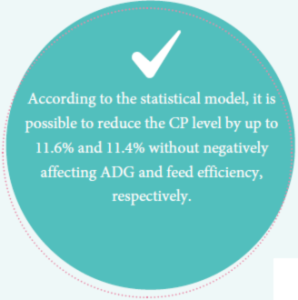
These levels are within the range recommended by NRC (2012) for pigs in the first (12.1% CP) and second (10.5% CP) finishing phases, likely due to the consideration of both phases in our model.
On the other hand, the suggested levels are lower than the recommendations provided by the Brazilian Tables (Rostagno et al., 2017) for pigs in the finishing phase.
![]()
Thus, lower CP levels than those recommended in the Brazilian Tables (Rostagno et al., 2017) can be used without compromising zootechnical performance.
Taking into account the average daily gain (ADG), it is possible to supplement up to 0.24% L-lysine, which is equivalent to 0.30% L-lysine HCl or 0.40% L-lysine sulfate supplementation.

| Conclusions |
![]() In conclusion, there is a minimum level of crude protein that compromises swine performance, even when diets are balanced for all essential amino acids.
In conclusion, there is a minimum level of crude protein that compromises swine performance, even when diets are balanced for all essential amino acids.
![]() Evidently, there exists a critical threshold of CP below which non-essential amino acids, bioactive compounds, and other nutrients become limiting factors.
Evidently, there exists a critical threshold of CP below which non-essential amino acids, bioactive compounds, and other nutrients become limiting factors.
Based on the meta-analysis, considering ADG and feed efficiency, the minimum crude protein levels were estimated as follows:
- 18.4% and 18.3% for nursery pigs;
- 16.1% and 16.3% for growth,
- and 11.6% and 11.4% for finishing pigs, respectively.
![]() Furthermore, it was estimated that the highest levels of L-lysine (100% purity) to be supplemented without compromising performance were 0.42% in the nursery phase and 0.24% in the finishing phase. Additionally, a maximum supplementation level of 0.42% L-lysine is suggested for growing pigs.
Furthermore, it was estimated that the highest levels of L-lysine (100% purity) to be supplemented without compromising performance were 0.42% in the nursery phase and 0.24% in the finishing phase. Additionally, a maximum supplementation level of 0.42% L-lysine is suggested for growing pigs.
![]() Finally, the study revealed that a SID Lys:CP ratio of 6.6% is the point at which ADG and feed efficiency of nursery pigs are compromised.
Finally, the study revealed that a SID Lys:CP ratio of 6.6% is the point at which ADG and feed efficiency of nursery pigs are compromised.
This report is based on the article “Rocha, G. C., Duarte, M. E., & Kim, S. W. (2022). Advances, Implications, and Limitations of Low-Crude-Protein Diets in Pig Production. Animals, 12(24), 3478.”
You may also like to read: “The impact of amino acid levels during rearing on broiler breeder productivity.”
Source: This article was originally published as content in portuguese in nutriNews Brasil 2023
